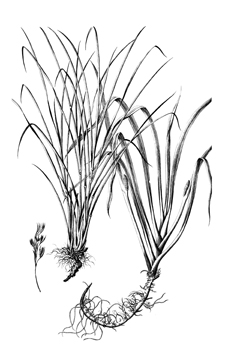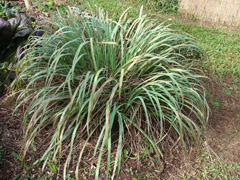 |
|
https://edibleplants.org/ |
 |
| Forest Starr & Kim Starr http://www.starrenvironmental.com/ |
Translate this page:
Summary
Lemon grass or Cymbopogon citratus is a tropical, evergreen, perennial grass that is aromatic and grows up to 1.5 m tall. It is also known as tanglad or sereh in the Philippines and Indonesia where it is profusely cultivated for its fragrant leaves that are used in cooking and brewing tea. The heart of the young shoots is cooked and eaten as a vegetable. The leaves and the essential oil are used in traditional medicine to relieve spasms and increase perspiration. It is also used to treat digestive ailments, arthritis pains, and various skin conditions. The essential oil can also be used in perfumery and making cosmetics and soaps. Lemon grass is used in swarm traps to attract swarms. It also has an ability to repel stable fly and is useful for soil improvement and erosion control. It is grown from division of established clumps.
Physical Characteristics

 Cymbopogon_citratus is an evergreen Perennial growing to 1.5 m (5ft) by 1.5 m (5ft) at a fast rate.
Cymbopogon_citratus is an evergreen Perennial growing to 1.5 m (5ft) by 1.5 m (5ft) at a fast rate.
See above for USDA hardiness. It is hardy to UK zone 10 and is frost tender. The plant is self-fertile.
Suitable for: light (sandy), medium (loamy) and heavy (clay) soils and prefers well-drained soil. Suitable pH: mildly acid, neutral and basic (mildly alkaline) soils and can grow in very alkaline soils.
It cannot grow in the shade. It prefers dry or moist soil and can tolerate drought. The plant can tolerates strong winds but not maritime exposure.
UK Hardiness Map
US Hardiness Map
Synonyms
Andropogon cerifer Hack. Andropogon ceriferus Hack. Andropogon citratus DC. Andropogon citratus DC.
Plant Habitats
Edible Uses
The heart of the young shoots is eaten as a vegetable with rice[ 301 ]. The basal portions of the leafy shoots have a delicious lemon-like aroma and are used as a flavouring in soups, sauces and curries[ 301 , K ]. Older leaves can be cooked with other foods in order to impart their lemon-like flavour. They are removed before serving[ 301 ]. A refreshing tea can be brewed from the leaves[ 301 ]. It can be served hot or cold[ 301 ]. It can be sweetened with sugar[ 521 ]. The essential oil is used as a flavouring in the food industry in soft drinks and various foods[ 238 , 418 ].
References More on Edible Uses
Medicinal Uses
Plants For A Future can not take any responsibility for any adverse effects from the use of plants. Always seek advice from a professional before using a plant medicinally.
Lemongrass was one of the herbs that was transported along the spice route from Asia to Europe. Lemon grass is a bitter, aromatic, cooling herb that increases perspiration and relieves spasms[ 238 ]. The essential oil obtained from the plant is an effective antifungal and antibacterial[ 238 ]. The essential oil contains about 70% citral, plus citronellal - both of these are markedly sedative[ 254 ]. Internally, the plant is used principally as a tea in the treatment of digestive problems, where it relaxes the muscles of the stomach and gut, relieving cramping pains and flatulence[ 254 ]. It is particularly useful for children, for whom it is also used to treat minor feverish illnesses[ 238 , 254 ]. Externally, especially in the form of the extracted essential oil, the plant is a very effective treatment for a range of conditions including athlete's foot, ringworm, lice and scabies[ 238 ]. It is also applied to ease the pain of arthritic joints[ 254 ].
References More on Medicinal Uses
The Bookshop: Edible Plant Books
Our Latest books on Perennial Plants For Food Forests and Permaculture Gardens in paperback or digital formats.

Edible Tropical Plants
Food Forest Plants for Hotter Conditions: 250+ Plants For Tropical Food Forests & Permaculture Gardens.
More

Edible Temperate Plants
Plants for Your Food Forest: 500 Plants for Temperate Food Forests & Permaculture Gardens.
More

More Books
PFAF have eight books available in paperback and digital formats. Browse the shop for more information.
Shop Now
Other Uses
Lemon Grass can be used as a companion plant to deter pests. It is also useful for improving soil quality and preventing erosion due to its dense root system.
Landscape Uses: Border, Container, Erosion control, Ground cover, Massing, Specimen. Agroforestry Uses: A good soil conditioner in worn out land. The plants quickly produce a bulk of organic material which soon rots down, attracting worms and other beneficial creatures and quickly enriching the soil[ 296 ]. A row of lemongrass plants can be used as a divider in the garden - it can help to contain more invasive plants such as sweet potato, and also as a barrier to prevent weeds growing into the garden[ 296 ]. The grass is useful for soil improvement and erosion control[ 418 ].. Other Uses An essential oil obtained from the plant is used in perfumery, scenting soaps, hair oils, cosmetics and as an insect repellent[ 238 , 254 , 418 ]. It is also used in the synthesis of vitamin A[ 418 ]. It is cytotoxic, which could be exploited for pesticidal or chemotherapeutic agents. It has insecticidal, larvicidal, nematicidal, pro-oxidative, repellent activity and is a vasorelaxant. 1. Nectary - Flowers rich in nectar and pollen:
Yes – Lemon Grass produces small flowers that can attract pollinators, providing some nectar, although it is primarily grown for its aromatic leaves.
2. Wildlife - Food (Fruit, Seeds, Leaf litter, Shelter, Nesting, Roosting):
No – While the leaves are edible for humans and can be used in cooking and teas, they do not provide significant food sources for wildlife in terms of fruit or seeds. The dense growth may provide some shelter but is not primarily a habitat for nesting or roosting.
3. Invertebrate Shelter (Overwintering sites, Leaf litter, Groundcover):
No – Lemon Grass does not typically provide substantial overwintering sites or leaf litter for beneficial insects. However, it can offer some ground cover in garden settings.
4. Pest Confuser (Smell):
Yes – Lemon Grass is known for its strong citrus scent, which can deter certain pests, making it effective as a natural pest confuser in gardens.
Special Uses
References More on Other Uses
Cultivation details
A plant of the tropics and subtropics, where it is found at elevations up to 1,400 metres. It grows best in areas where annual daytime temperatures are within the range 24 - 30°c, but can tolerate 18 - 34°c[ 418 ]. It can be killed by temperatures of 10°c or lower[ 418 ]. It prefers a mean annual rainfall in the range 1,500 - 3,000mm, but tolerates 700 - 4,200mm[ 418 ]. Prefers a moisture-retentive soil in full sun[ 200 ]. Prefers a pH in the range 5 - 5.8, tolerating 4.3 - 7.3[ 418 ]. Harvesting begins when the crop is 120 - 240 days old, and the plant is subsequently harvested every 90 - 120 days[ 418 ]. The plant has an economical life of 4 years[ 418 ]. Fresh grass yields 0.2 - 0.4% oil, with an average yield of 50 - 120 kilos of oil/ha per annum. Yield of foliage is higher on fertile heavy soils, but under these conditions the oil usually has a lower citral content[ 418 ] The plant seldom flowers[ 418 ]. Lemongrass should be stored separately from other foods, or should be well wrapped, otherwise its strong scent will taint the other foods[ 200 ]. Lemon Grass can be harvested throughout the growing season, but it is usually best harvested from late spring to early autumn when the stalks are young and tender.
Lemon Grass typically flowers from late summer to early autumn, though it is often grown for its foliage rather than its flowers. Under ideal conditions, it grows quickly and can reach maturity in about 3 to 4 months. It can grow up to 3 to 5 feet tall.
References Carbon Farming Information and Carbon Sequestration Information
Temperature Converter
Type a value in the Celsius field to convert the value to Fahrenheit:
Fahrenheit:
The PFAF Bookshop
Plants For A Future have a number of books available in paperback and digital form. Book titles include Edible Plants, Edible Perennials, Edible Trees,Edible Shrubs, Woodland Gardening, and Temperate Food Forest Plants. Our new book is Food Forest Plants For Hotter Conditions (Tropical and Sub-Tropical).
Shop Now
Plant Propagation
Seed. Division of established clumps. This is best done annually or they can become too crowded and suffer.
Other Names
If available other names are mentioned here
Lemon grass or Cymbopogon citratus. Also know as: citronella grass, citron grass; fever grass; lemongrass; West Indian lemongrass. Spanish: hierba limon; pasto lim—n; sontol; te limon; zacate de lim—n; zacate dete; zacate lim—n. French: citronelle; herbe citron; verveine des Indes. Chinese: xiang mao. Brazil: cana-cidreira; cana-lim‹o; capim-cidr—; capim-santo; erva-cidreira; patchuli-falso; yerbaluisa. Germany: Lemongras; Zitronellgras; Zitronengras. India: bhustarah; gandhabene; gandhatran; injippullu; khavi; lilacha; majjigehallu; nimmagaddi; vasanapullu. Indonesia: sereh. Italy: citronella. Myanmar: sabalin. Peru: yerba Luisa. Saint Lucia: sitonnl. Sri Lanka: sereh. Vietnam: sa chanh.
Native Range
India, Sri Lanka
Weed Potential
Right plant wrong place. We are currently updating this section.
Please note that a plant may be invasive in one area but may not in your area so it's worth checking.
Some indication it has been invasive in Saint Lucia, Caribbean.
Conservation Status
IUCN Red List of Threatened Plants Status : This taxon has not yet been assessed.

Growth: S = slow M = medium F = fast. Soil: L = light (sandy) M = medium H = heavy (clay). pH: A = acid N = neutral B = basic (alkaline). Shade: F = full shade S = semi-shade N = no shade. Moisture: D = dry M = Moist We = wet Wa = water.
Now available:
Food Forest Plants for Mediterranean Conditions
350+ Perennial Plants For Mediterranean and Drier Food Forests and Permaculture Gardens.
[Paperback and eBook]
This is the third in Plants For A Future's series of plant guides for food forests tailored to
specific climate zones. Following volumes on temperate and tropical ecosystems, this book focuses
on species suited to Mediterranean conditions—regions with hot, dry summers and cool, wet winters,
often facing the added challenge of climate change.
Read More
Expert comment
Author
(DC. Ex Nees) Stapf
Botanical References
Links / References
For a list of references used on this page please go here
A special thanks to Ken Fern for some of the information used on this page.
Readers comment
| Add a comment |
|
If you have important information about this plant that may help other users please add a comment or link below. Only comments or links that are felt to be directly relevant to a plant will be included. If you think a comment/link or information contained on this page is inaccurate or misleading we would welcome your feedback at [email protected]. If you have questions about a plant please use the Forum on this website as we do not have the resources to answer questions ourselves.
* Please note: the comments by website users are not necessarily those held by PFAF and may give misleading or inaccurate information.
To leave a comment please Register or login here All comments need to be approved so will not appear immediately.
|
Subject : Cymbopogon_citratus
|
|
|
|